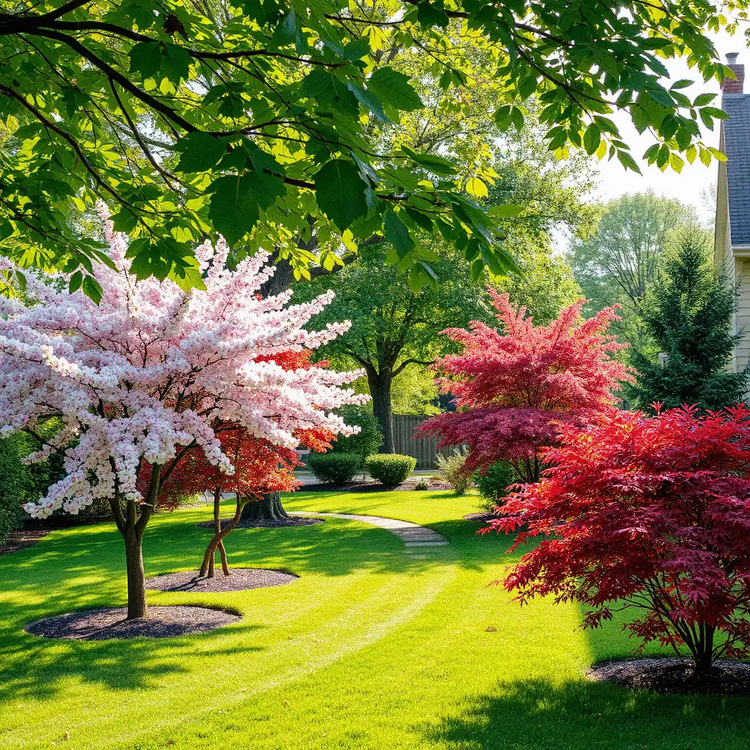Dogwood
Stunning blossoms in spring, adding charm to any garden.
2025-06-22
Imagine transforming your yard into a stunning sanctuary filled with vibrant colors, unique shapes, and a welcoming atmosphere. Ornamental trees are key players in this transformation, offering not just beauty but also functional benefits. By understanding their role and selecting the right species, you can create a thriving outdoor space that enhances your home.
Explore the standout characteristics of ornamental trees that enhance residential landscapes.
Stunning blossoms in spring, adding charm to any garden.
Breathtaking displays of pink and white flowers in spring.
Large, fragrant flowers make a dramatic statement.
Colorful fruits with lovely blooms for both ornamental and functional use.
When it comes to enhancing our homes, ornamental trees play a vital role in creating inviting landscapes. Not only do they add beauty, but they also provide shade and shelter, contributing to the overall ecosystem of our yards. As we explore these trees, I find it fascinating how each species can dramatically change the feel of a garden or outdoor space.
Choosing the right ornamental tree for your home is essential. This selection can affect not just the aesthetics but also the health and sustainability of your garden. At Deep Roots Journal, I emphasize the importance of understanding which species thrive in your specific environment, ensuring you make an informed decision that benefits both your property and the surrounding ecosystem.
The first step in creating a beautiful landscape is choosing the right ornamental tree species. Each type brings unique characteristics that can enhance your yard in different ways. For instance, some species are known for their striking flowers, while others might offer vibrant foliage or impressive growth patterns. To ensure the longevity and beauty of your trees, consider essential tree care and landscaping.
When selecting an ornamental tree, consider factors such as growth habits, climate adaptability, and maintenance requirements. Each of these aspects can influence the tree's longevity and its integration into your landscape. By choosing wisely, you set the stage for a thriving outdoor space.
Ornamental trees are not just pretty to look at; they also serve significant purposes in our yards. They can provide shade on hot summer days, create a sense of privacy, and even attract wildlife, enriching our gardens' biodiversity. Each of these benefits contributes to a more sustainable and enjoyable outdoor space.
From a visual standpoint, ornamental trees can be focal points in your landscape design. Their vibrant colors and unique shapes can draw the eye and create a beautiful contrast with surrounding plants. Incorporating these trees into your yard can lead to a more harmonious and engaging environment. If you are looking for trees that provide quick shade, check out fast-growing trees.
Here's a brief recap of the key points discussed so far:
If you have a small yard, there are several ornamental trees that fit beautifully without overwhelming your space. Here are some excellent choices:
Caring for ornamental trees might seem daunting, but it can be simplified by following a seasonal routine. Here’s a straightforward guide:
By following these care tips, you’ll keep your ornamental trees healthy and flourishing throughout the year. Embrace the beauty of nature in your yard, and remember—every tree you plant contributes to a vibrant ecosystem!
When it comes to enhancing your residential landscape, ornamental trees stand out as a fantastic choice. They offer both beauty and functionality, making them a perfect addition to any yard. At Deep Roots Journal, I’ve explored some of the most popular species, and I’m excited to share a summary of my top choices for residential yards!
Here are the standout species that consistently impress homeowners:
Choosing the right ornamental tree not only enhances your yard’s aesthetic but also contributes to biodiversity and soil health. Remember, each species has its unique requirements, so it’s crucial to consider your garden’s specific needs when selecting. Understanding your local tree species can also help in making the right choice for your area; for more information, see our guide on identifying local tree species.
When selecting ornamental trees for your property, there are several important factors to keep in mind. Understanding your space and the specific characteristics of each tree will help ensure you make a wise choice. Here are some key considerations to think about:
By taking these factors into account, you can select ornamental trees that will flourish in your yard. The right choice will not only beautify your space but also create a vibrant ecosystem that benefits both plants and wildlife.
Now that you’re equipped with knowledge about popular ornamental trees, it’s time to take action! Enhancing your yard can be a rewarding experience, and consulting with a professional can help you make the best decisions. I recommend reaching out to a landscape designer who can offer tailored recommendations based on your unique needs.
Working with a landscape designer is a valuable step in the process. These experts can help you understand the unique requirements of your space and suggest the best tree species to complement your garden. Here are some benefits of consulting with a designer:
Taking this step can save you time and effort, ensuring you invest in trees that will thrive in your landscape. To ensure your trees thrive, it’s also crucial to understand how to encourage healthy root development.
Once you’ve decided on the ornamental trees you want, the next step is sourcing them! There are several excellent options for purchasing trees, each with its advantages. Here’s where to start your search:
Wherever you choose to buy, don’t hesitate to ask questions and seek guidance. At Deep Roots Journal, I believe that knowledge is key to nurturing a thriving garden! With the right ornamental trees, your yard can become a stunning sanctuary.
Here is a quick recap of the important points discussed in the article:
